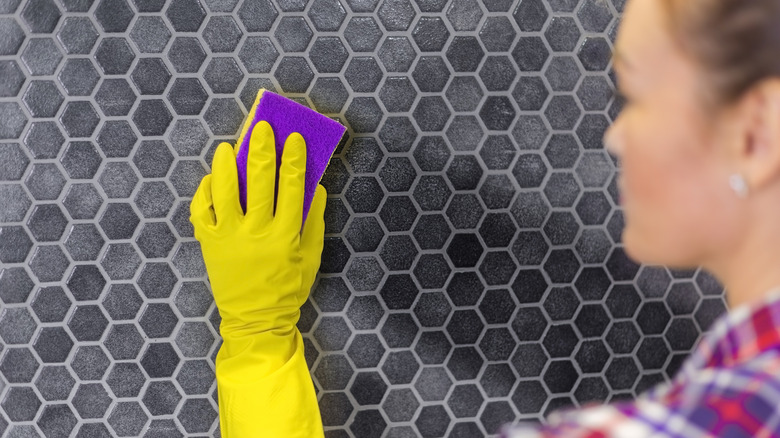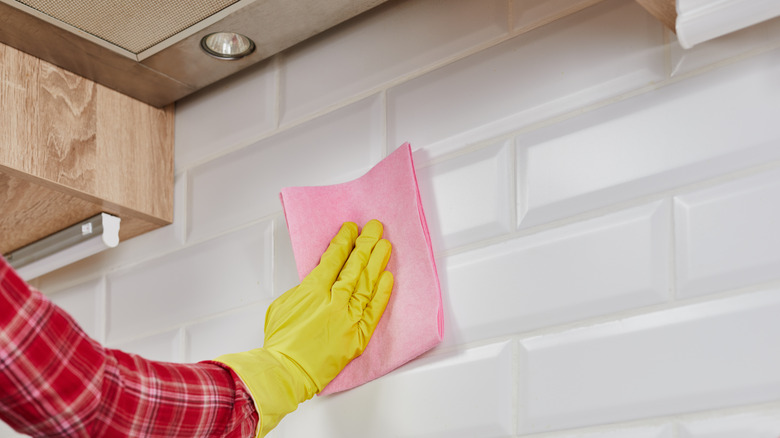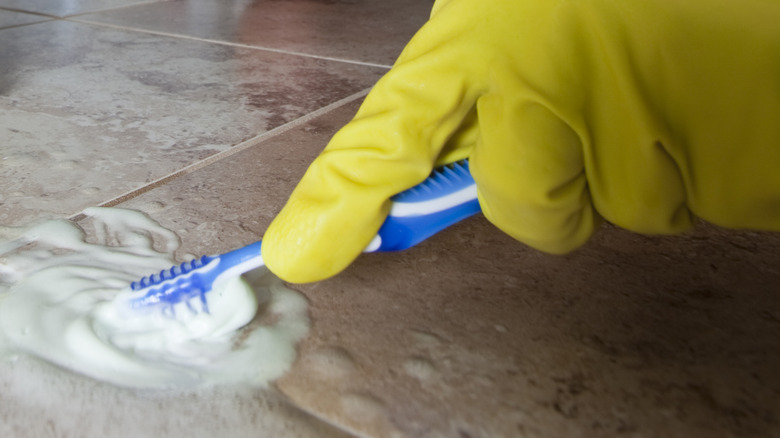The Best Way To Clean Your Tiled Kitchen Backsplash
When it comes to cooking, you're probably most familiar with vinegar as the ingredient that lends sauce its sharpness and can add an extra bit of body to your dish. Vinegar can also be a useful tool for cleaning your kitchen after you're finished making the meal, which will make you wish you knew this vinegar hack sooner. There is truly no shortage of surprising things vinegar can do.
Baking soda is best known as the ingredient that makes your delicious desserts rise to the occasion. This powder can also be used to keep your kitchen free from unsightly stains, but you have to know how to clean with it. For kitchen tile upkeep, all you need to do is mix either baking soda or vinegar with water, and you'll be ready to give your tile kitchen a certain sparkle. Which chemical you use for the cleaning project will depend on the material that the tile is made out of, as will the tools you use.
The best solution for a dirty kitchen
When you're mixing together a chemical cleaner to make your tiles twinkle, the amount of each liquid that you use in the mixture is important. Vinegar, for example, should be combined with water at a 1 to 1 ratio. However, vinegar cleaner isn't recommended if you're cleaning kitchen tiles made from marble or granite, as it can significantly lessen your the surface's shine. For these types of tile, you should use a stone-specific solution.
Hydrogen peroxide is a much more acidic chemical compound and should be used sparingly. One cup of hydrogen peroxide will be enough to transform a gallon of water into a cleaning solution. Alternatively, you can use a mush made out of baking soda and water to scrub these tiles. Simply spread or spray either mix on the kitchen tile in question, allow it to rest for a moment, then take a towel and wipe the solution off. Sometimes, a coarser cloth is required, but if the tile is made from stone, abrasive scrubbing tools can cause scratches.
But be warned! making of mix of certain chemicals can cause catastrophic reaction. A solution of vinegar and bleach will give off toxic chlorine gas, and a mix of hydrogen peroxide and vinegar creates the chemical irritant peracetic acid. As such, when you use these cleaning products, be cautious of what chemicals come into contact with one another.
More tips for a clean kitchen
One of the most important aspects of keeping your kitchen tile clean is making sure that the grout is not neglected. If you aren't aware, grout is the material that is packed between each individual tile in order to seal the surface that they comprise from outside invaders. However, though grout acts as an effective barrier for kitchen messes, it can become unsightly over time. For standard white grout, mix bleach and water together and scrub the grout gorges with either a specific scrubbing tool or a standard toothbrush. Bleach may strip away some pigment while cleaning, so it's recommended that you use a vinegar solution on colored grout instead.
After you clean the dirty grout, scrub off any remaining residue with a wet washcloth. This step is an important facet of the entire tile cleaning process. Wiping down a kitchen backsplash with water will help mitigate any long term effects that a cleaning product might have on your kitchen, and drying the tile to finish your project will prevent water damage from forming.


